]
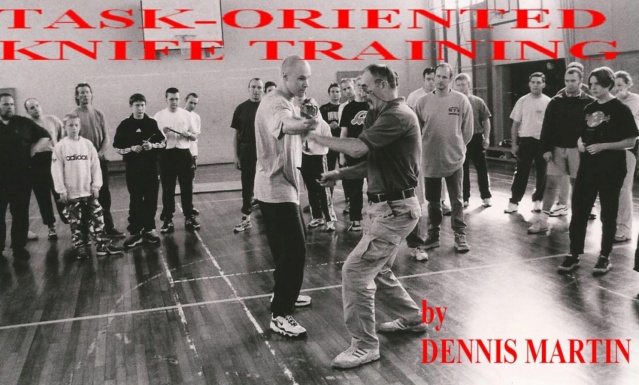
In order to devise a training program for the EDC knife, it is first essential to perform a task analysis of all the relevant factors. Before deciding on a particular knife and carriage-position you will have already assessed your lifestyle, work, clothing etc. However, we must go beyond these criteria, to assess the conditions under which you are likely to employ the knife, and also how it fits in with your other force options. Having done this we can engage in task-orientated training, to give us the motor skills we need to perform under intense stress. In this article we are going to discuss some considerations regarding training knives and knife training in a generic self-protection role, but we are aware that specific cases require specific training. If you are a uniformed police officer, a Close Protection Operator, or, if you are handicapped in some way, you will need to add training drills specifically for that situation.
SITUATIONSAndy Langley, former Rhodesian SAS, used to teach two types of violent confrontation:
1] Brewing
2] Flash
A “brewing” situation is progressive deterioration. You are in a verbal altercation and things are going bad. Or, you are approaching your car and you see a couple of potential baddies lurking nearby.
In a face-to-face close confrontation it is unlikely that your enemy will allow you to draw your knife. Any move toward the beltline, or, pockets is obviously “dodgy” and he will stifle it, just as you would do if he made a furtive move. If you are subtle and discreet enough you may succeed. W.E. Fairbairn reportedly studied conjuring sleight of hand masking and distracting ploys, for the very purpose of accessing the knife in these conditions. Obviously, this sort of thing should be tested in training.
Concerning those situations where you go into potential threat, such as a car park at night, we maintain a high degree of situational awareness. We may be able to discreetly palm the EDC knife, to a more accessible state of readiness. Therefore, our training should include starting with the folder closed in the hand, with the folder opened (or, obviously fixed-blade), but concealed, for example behind the thigh.
A “flash” situation is an immediate assault. You turn round right into a hands on situation. You need to train on defensive and offensive striking techniques to gain a position of dominance to be able to deploy the knife.
Before describing the actual drills, let’s discuss the types of training knives we need.
TRAINING KNIVES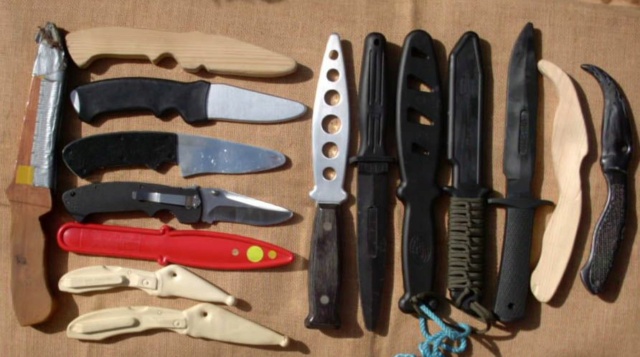
]
We use three types:1] Rigid trainer. This is used for many of the longer slash/thrust training sequences with a partner. Ideally, wood, or, plastic. Although the knife relies on speed rather than impact, when you are really motoring those strikes can hurt, so we want a very dull, light trainer. I bought a metal trainer and only used it on my partner once! Metal is fine for solo training, but not on a partner, unless you use protective padding.
 [Various types of training knife: Top is a Cold Steel rubber subhilt fighter; middle is a Strider plastic fighter, bottom is a metal Spyderco Civilian trainer]
[Various types of training knife: Top is a Cold Steel rubber subhilt fighter; middle is a Strider plastic fighter, bottom is a metal Spyderco Civilian trainer]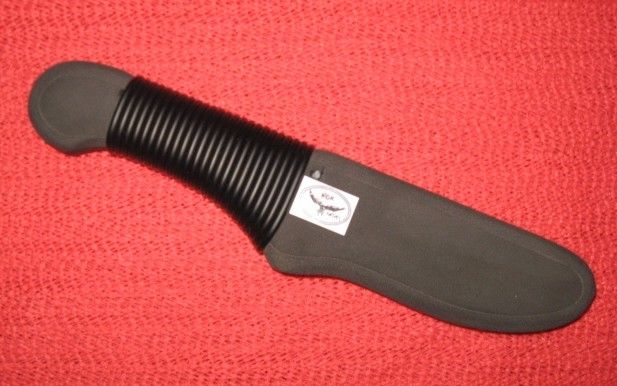 [The best safe trainer is this design from Nok]
[The best safe trainer is this design from Nok]2] Safe folder. This is a replica of your Tactical Folding Knife (TFK) with dulled edge and point. Spyderco, Ernest Emerson and Benchmade all make safe versions of some of their models. Alternatively buy two knives and have one made into a trainer by grinding and polishing all sharp edges. You can now practice weapon-access drills with a replica carried exactly as of your favourite EDC. As noted above, full speed/power strikes with a metal trainer will soon use up partners, so either moderate force, or use protective padding.
 [Folders and their trainers: "A"= Emerson CQC-7, "B" is their dedicated trainer. "C" = Kasper Folder; "D" is a converted trainer. "E" is a generic commercial trainer, while at "F" we have two cheap folders dulled and converted to safe trainer]
[Folders and their trainers: "A"= Emerson CQC-7, "B" is their dedicated trainer. "C" = Kasper Folder; "D" is a converted trainer. "E" is a generic commercial trainer, while at "F" we have two cheap folders dulled and converted to safe trainer]3] Finally, you will need to use your actual EDC for some of the training.
SAFETYThe following safety procedures are essential:-
1] When doing any partner work, both parties must wear impact-resistant eye-protection at all times. Even soft rubber trainers can damage an eye.
2] Never work with a live blade when doing partner drills. All live blades should be placed in your training bag while doing partner drills. Some guys mix live and training knives on body, and this is a recipe for disaster. That trainer feels just like the real thing, so you will have no cue if you inadvertently draw your live blade and cut your partner. Learn from the shooters, and secure all live weapons in a nominated. location.
3] If training on live blade drills in a class ensure there is sufficient safety distance between trainees.
4] Have a safety monitor work with each pair, to ensure things don’t get out of hand.
We will now examine some drills to put these concepts into practice.
TRAINING DRILLSIn the following drills we are assuming that your favourite self-protection knife is a folder. Obviously, most drills will also work with a fixed blade. We have gathered these drills from various sources. Most are our own creation, others from instructors we respect.
A} RIGID TRAINER
1] PADWORK
Partner holds on impact pad. Strike with combination slashes and stabs. This gets you used to impact, and maintaining a firm grip, while working at speed. Add strikes and grabs with your offhand.
2] PRE-EMPTIVES
This series replicates situations where you have discreetly accessed your knife, in readiness for potential attack. Have your partner engage you, initially verbally, but then escalating. Pick the assault cue and pre-empt with appropriate slashes.
3] RELEASES
Similar to the first drill, but while the first guy engages you verbally, another grabs you with any realistic hold. Work on “cutting loose”
B} TRAINING FOLDER
It is important to wear clothing similar to your normal lifestyle. Have the training TFK clipped in your normal position.
1] GROUNDWORK
Start back to back on ground. On signal spin round and your partner seeks to immobilise you.
Access your training knife and cut/stab opportune targets. During successive repetitions partner should place you in various positions of disadvantage, including restraining your masterside hand. Can you readily draw the knife with your weak hand?
2] STRESS DRAW
We adapted this from our Tactical Pistol program. Partner stands beside you and taps your shoulder as “go” signal. You access your training folder, to ready position. Partner will interfere with draw, grab covering garment, impede your arm, push/pull you off balance. Your job is to complete the draw.
Bob Kaspar teaches a drill having your partner slap you around the head while you draw. This certainly adds realism!
3] CHOKE RELEASE.
First partner holds impact pad, and you start striking/kicking. At random, second partner attacks with rear chokehold. You must immediately access TFK and cut his arm before you’re choked out. Note, this is an essential drill, because it’s the only escape from a choke attack by someone who knows what he’s doing.
C} LIVE BLADE
Be especially careful when training with the live blade. Ensure that the lock will hold against stress. Keep safe distance from all others.
1] ARM TARGET
This is a long pole covered with foam, then wrapped with an old jacket sleeve (I prefer to use an old bomber jacker, very common street wear).
 [Terry O'Neill holding arm target]
[Terry O'Neill holding arm target]Ideally a circular shield should separate the target area from the holder. Don Rearic suggests taping a wooden knife, or broken bottle (plastic) to the end.
a] BASICS
Start knife in hand, keep your other hand back in Largo Mano style and just practice simple defanging cuts. This gets you used to blade drag and impact. When proficient, add the checking hand action. Finally, include draw to strike training.
b] STRESS DRAW
On signal, drop and perform one pushup, spring up, draw and perform one cut, replace knife, drop, two pushups then two cuts, and so on up to five pushups and five cuts. This adds “loading” to the limbs and tests dexterity under physical stress.
c] TRANSITION DRILL
First partner holds impact pad, and you start striking/kicking. At random second partner pokes your back with the arm target. Draw and cut the arm. This tests ability to draw from a striking situation.
-------------------------------
2] TRAINING DUMMY
The version pictured was built in South Africa. The arms are moveable, the torso head and neck are padded for all blade attacks, and the entire unit is mounted on a wheeled base and can be moved around by the partner.
 [Den demonstrating the original dummy in RSA]
[Den demonstrating the original dummy in RSA]a] THRUSTS
Work on thrusts from all angles. Beware, folders lack a guard and it’s easy for the hand to slip onto the blade. Start light and work up to full force. Add slash patterns and integrate with thrusts.
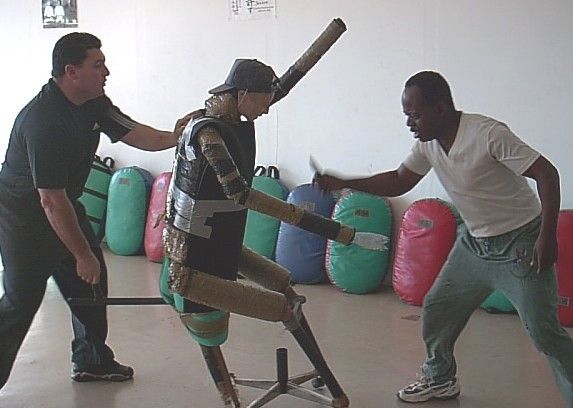
[Dummy in use during one of our courses in Jo'burg]
b] STRESS DRILL
Partner holds an electronic stun gun to your offside shoulder. Start signal is the juice going into you! Shocking continues until you have drawn your weapon and made the specified cuts.
Obviously, great care needs to be done with this, and I recommend working with the training folder first, as each individual reacts differently to the shock. This is a real learning experience, and it’s good to video the exercise for subsequent review.
3] TIMER DRILLS
If you have an electronic timer, used for shooting, you can do some useful solo training. Just as you need the dummy to test accuracy and impact force, so the timer quantifies speed. If you position a balloon as your target and adjust the timer sensitivity, them hit the start button, there is a random delay, then on the tone draw and stab the balloon, and the pop will stop the timer. You then get a readout of you exact time.
This is valuable for evaluating different models of TFK, or, different carriage positions, although I would caution against going for all out speed. Work on a smooth access… “smoothness is five sixths of speed”
INTEGRATED TRAINING [Equipment for integrated training]
[Equipment for integrated training]Do you carry OC, do you carry a pistol, do you carry an impact weapon, do you carry a flashlight. The knife must be fully integrated with all of these options.
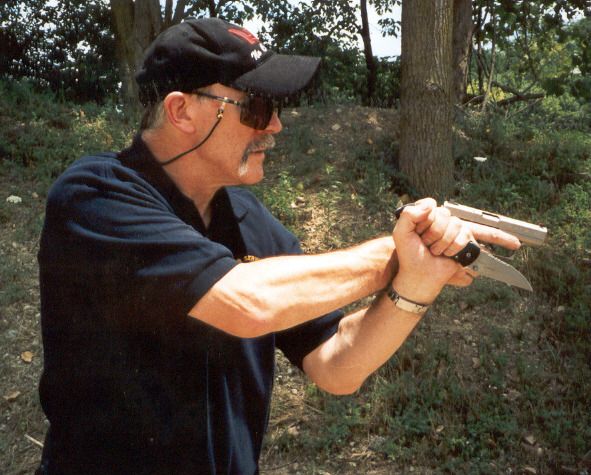
On range, have your partner load your magazine with a random number of rounds, and go through a shooting drill. When the weapon stops, switch it to your support hand and access the knife. Sure you train on reloads, or going to a backup gun; but make sure that you are also proficient in pistol/knife transitions too.
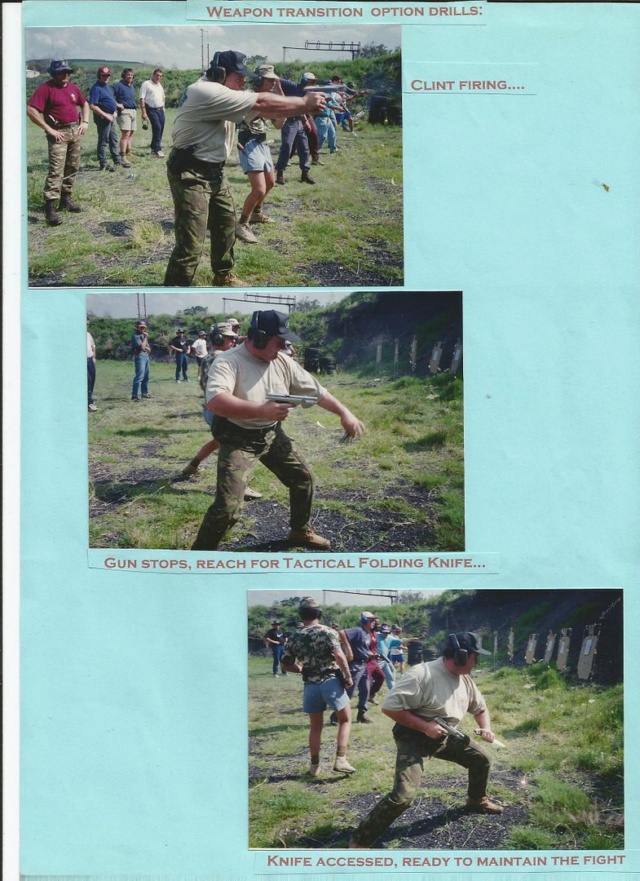 [Clint during pistol to knife transition drill]
[Clint during pistol to knife transition drill]This is a big subject, and an ever-evolving subject. None of the drills outlined are carved in stone. Modify them, add to them, create new versions. As long as you go for a reality base, and keep safety in mind, you can add to the library of drills.
+++++++
LINKS
Forum thread on
training knivesNok training knives.
